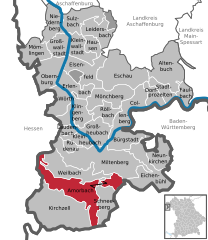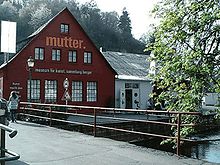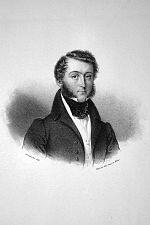Amorbach
This article needs additional citations for verification. (July 2015) |
Amorbach | |
|---|---|
 View of Amorbach | |
Location of Amorbach within Miltenberg district  | |
Unterfranken | |
| District | Miltenberg |
| Government | |
| • Mayor (2020–26) | Peter Schmitt [1] (CSU) |
| Area | |
| • Total | 50.92 km2 (19.66 sq mi) |
| Elevation | 165 m (541 ft) |
| Population (2022-12-31)[2] | |
| • Total | 3,933 |
| • Density | 77/km2 (200/sq mi) |
| Time zone | UTC+01:00 (CET) |
| • Summer (DST) | UTC+02:00 (CEST) |
| Postal codes | 63916 |
| Dialling codes | 09373 |
| Vehicle registration | MIL |
| Website | amorbach.de |
Amorbach (German: [ˈaːmoːɐ̯ˌbax] ⓘ) is a town in the Miltenberg district in the Regierungsbezirk of Lower Franconia (Unterfranken) in Bavaria, Germany, with some 4,000 inhabitants. It is situated on the small river Mud, in the northeastern part of the Odenwald.
History

The town began as a
Amalgamations
The following settlements have been amalgamated with the town:
- 1 April 1973: Boxbrunn
- 1 January 1975: Beuchen
- 1 January 1976: Neudorf
- 1 January 1976: Reichartshausen
Economy
Today Amorbach relies on the tourist business with its state recognition as a climatic spa (Luftkurort) and its many Baroque buildings.
Amorbach is the family seat of the princely Haus zu Leiningen. In 1992, the town was awarded the Europa Nostra Medal.
Arts and culture


Abbey church
The Benedictine abbey, formerly owned by the princely Haus zu Leiningen with its library, and the abbey church with its Stumm organ draw thousands of visitors each year.
Parish church St. Gangolf

The late-Baroque hall church St. Gangolf replaced an earlier one, St. Gangolf and St. Sebastian, documented for 1182. It was built in 1751-3 by local Oberamtmann Johann Franz Wolfgang Damian von Ostein and his brother and Archbishop, Johann Friedrich Karl von Ostein. The design was based on plans by Anselm Franz von Ritter zu Groenesteyn, building work was supervised by his apprentice Alexander Jakob Schmidt. The design was inspired by St. Peter's Church at Mainz. The interior reflects Rococo style and the onset of the Neoclassical style. Ceiling frescoes by Johannes Zick show the lives of St. Gangolf (Gangulphus) and Saint Sebastian as well as King David as the "father" of Solomon's Temple. Oil paintings in the choir by Konrad Huber depict the legendary beginnings of Amorbach. The marble high altar was made by Georg Schrantz, while Josef Keilwerth added the four statues. The cross by J.B. Berg dates from 1808. The side altars (1720) were originally used in the predecessor building. The organ also dates from 1720, but was located at Neustadt am Main Abbey until 1806, when it was bought by the Amorbach parish. The church has two pulpits, made from stucco by Antonio Rossi.[3]: 84–5
St. Gangolf is the Catholic parish church of Amorbach.
Museums

The Sammlung Berger mit Teekannenmuseum is a museum of art and teapots. Besides impressive exhibits of modern art by
and others, the museum also shows a teapot collection of 2,467 teapots from throughout the world and roughly 500 miniature teapots.Tithe barn
The tithe barn in Amorbach, built in 1488, has for five hundred years played a central role in the town. Originally built to store tithes in the form of produce for the prince, it was – after extensive remodelling in the 1960s – run as a cinema.
The Kulturkreis Zehntscheuer Amorbach e.V. (“Amorbach Tithe Barn Cultural Circle”), which outfitted the building in 1991 as a cabaret theatre maintains and renovates the building, which stands in the historical town centre. In 2001, this club bought the tithe barn.
Regular events

- Amorbach Abbey Concerts in the former Benedictine abbey church
- Cabaret programme at the cabaret theatre Zehntscheuer Amorbach
- Daily at 12:00 and 15:00, the Stumm organ (1782) with its 5,116 pipes is played
- Each year on Mother’s Day, the so-called Gangolfsritt (“Gangulphus’s Ride”), a procession of horses through the town, takes place.
Infrastructure
Transport
In Amorbach,
Education
- Karl-Ernst-Gymnasium Amorbach
- Theresia-Gerhardinger-Realschule;
- Parzival-Hauptschule;
- Wolfram-von-Eschenbach-Grundschule (primary school).
Notable people
Sons and daughters of the town


- Johann Amerbach, (c. 1440-1513), printer and publisher in printing’s early days;
- Bishop of Worms, historian;
- Karl Haßloch (1769–1829), stage actor and operatic singer;
- Carl, 3rd Prince of Leiningen (1804-1856); elder half-brother of Queen Victoria.
- Princess Feodora of Leiningen (1807-1872); elder half-sister of Queen Victoria.
- Archbishop of Munich and Freising(1898–1909);
- phytopathologist (1902–33 professor in Munich);
- Georg Stang (1880-1951), Bavarian politician and president of the Bavarian State Parliament
- Ernst Leopold, 4th Prince of Leiningen(1886-1939); son of the 3rd Prince of Leiningen.
- Oskar Martin-Amorbach, (1897-1987), painter and professor in Munich and Berlin;
- Klemens Schnorr (1949-), German organist and musical scientist;
- Vince Ebert (1968-), scientist-cabaret performer and writer;
- Philipp Weber (1974-), cabaret performer and writer;
Died in Amorbach
- Carl Friedrich Wilhelm, 1st Prince of Leiningen(1724-1807);
- Carl, 3rd Prince of Leiningenand Princess Feodora of Leiningen.
- Princess Victoria Melita of Saxe-Coburg and Gotha (1876–1936); granddaughter of Queen Victoria through her son Alfred, Duke of Saxe-Coburg and Gotha and his wife, Grand Duchess Maria Alexandrovna of Russia.
Further reading
- Norbert Schmitt “Amorbacher Familienbuch 1618-1913, mit Angaben über die Familien von Amorbach (Stadt), Beuchen; Boxbrunn (mit Neidhof), Buch (mit Walkmühle); Gönz (mit Sansenhof; bis 1878); Gottersdorf (mit Kummershof; bis 1908); Neudorf, Otterbach (mit Schafhof); Reichartshausen und Zittenfeld, sowie Schneeberg und Hambrunn (1618-1688)”; Verlag = Pfarrgemeinde St. Gangolf, Amorbach, 1998
References
- Bayerisches Landesamt für Statistik, 15 July 2021.
- ^ Genesis Online-Datenbank des Bayerischen Landesamtes für Statistik Tabelle 12411-003r Fortschreibung des Bevölkerungsstandes: Gemeinden, Stichtag (Einwohnerzahlen auf Grundlage des Zensus 2011) (Hilfe dazu).
- ISBN 3-7701-0746-2.
External links
- Official website
 (in German)
(in German) - Amorbach Tithe Barn (in German)
- Amorbach. In: Meyers Konversations-Lexikon. 4th edition. Volume 1, Verlag des Bibliographischen Instituts, Leipzig/Vienna 1885–1892, p. 496.


